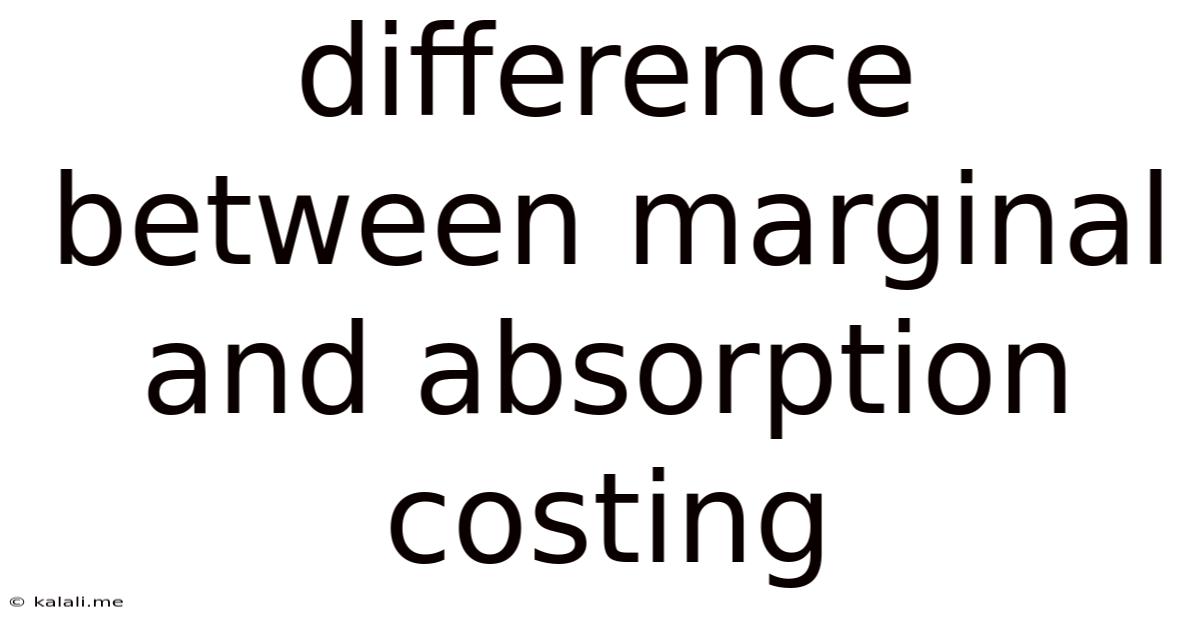Difference Between Marginal And Absorption Costing
Kalali
Jun 11, 2025 · 3 min read

Table of Contents
Marginal vs. Absorption Costing: A Comprehensive Guide
Understanding the differences between marginal costing and absorption costing is crucial for accurate financial reporting and effective managerial decision-making. Both methods calculate the cost of a product, but they differ significantly in how they treat fixed manufacturing overhead costs. This article will delve into the core distinctions, highlighting the advantages and disadvantages of each approach. This will equip you with a clear understanding of which method is best suited to your specific needs.
What is Marginal Costing?
Marginal costing, also known as variable costing, only includes variable costs in the calculation of the cost of goods sold (COGS). Variable costs are those that change directly with the level of production, such as direct materials, direct labor, and variable manufacturing overhead (e.g., indirect labor directly tied to production volume). Fixed manufacturing overhead costs, such as rent, depreciation on factory equipment, and salaries of factory supervisors, are treated as period expenses and are deducted from revenue in the period they are incurred. Therefore, the cost of a product under marginal costing is simply the sum of its direct materials, direct labor, and variable manufacturing overhead.
What is Absorption Costing?
Absorption costing, also known as full costing, includes all manufacturing costs – both variable and fixed – in the calculation of the cost of goods sold (COGS). This means that fixed manufacturing overhead costs are allocated to each unit produced, typically based on a predetermined overhead rate (often using machine hours or direct labor hours as the allocation base). This results in a higher per-unit cost compared to marginal costing. The fixed overhead costs are spread across all units produced, influencing inventory valuation and profit calculation.
Key Differences Between Marginal and Absorption Costing: A Table Summary
| Feature | Marginal Costing | Absorption Costing |
|---|---|---|
| Fixed Overhead | Treated as period expense | Allocated to units produced |
| Cost of Goods Sold (COGS) | Includes only variable manufacturing costs | Includes all manufacturing costs (variable & fixed) |
| Inventory Valuation | Only variable manufacturing costs included | Includes variable and fixed manufacturing costs |
| Profit Calculation | Profit directly influenced by sales volume | Profit influenced by both sales volume and production volume |
| Suitability | Better for short-term decision-making, pricing strategies | Better for external reporting and tax purposes |
Advantages and Disadvantages of Each Method
Marginal Costing:
Advantages:
- Simpler to understand and implement.
- Provides a clearer picture of the contribution margin. This is the difference between revenue and variable costs, indicating the amount available to cover fixed costs and generate profit.
- Useful for short-term decision-making, such as pricing decisions, special order acceptance, and make-or-buy decisions.
Disadvantages:
- Does not comply with Generally Accepted Accounting Principles (GAAP) for external financial reporting.
- Inventory is undervalued.
Absorption Costing:
Advantages:
- Complies with GAAP and is required for external financial reporting and tax purposes.
- Provides a more comprehensive product cost.
- Inventory is valued at its full cost.
Disadvantages:
- More complex to implement.
- Can distort the profitability picture, especially when production levels fluctuate. Fixed costs are spread across fewer units when production is low, leading to a higher per-unit cost and potentially lower reported profits.
- Less useful for short-term decision-making.
Choosing the Right Method
The choice between marginal and absorption costing depends on the specific purpose. Absorption costing is mandatory for external reporting and tax purposes, providing a complete picture of product costs. However, marginal costing offers significant advantages for internal decision-making, focusing on profitability directly related to sales. Many businesses use both methods, utilizing absorption costing for external reporting and marginal costing for internal management decisions. Understanding the strengths and weaknesses of each approach is crucial for effective financial management.
Latest Posts
Latest Posts
-
How Many Numbers Are Between 48 To 24
Jul 02, 2025
-
How Many Positions Are There In Sex
Jul 02, 2025
-
How Many Minutes Are In 10 Miles
Jul 02, 2025
-
How Many Milliseconds Are In A Day
Jul 02, 2025
-
If Your 16 What Year Were You Born
Jul 02, 2025
Related Post
Thank you for visiting our website which covers about Difference Between Marginal And Absorption Costing . We hope the information provided has been useful to you. Feel free to contact us if you have any questions or need further assistance. See you next time and don't miss to bookmark.